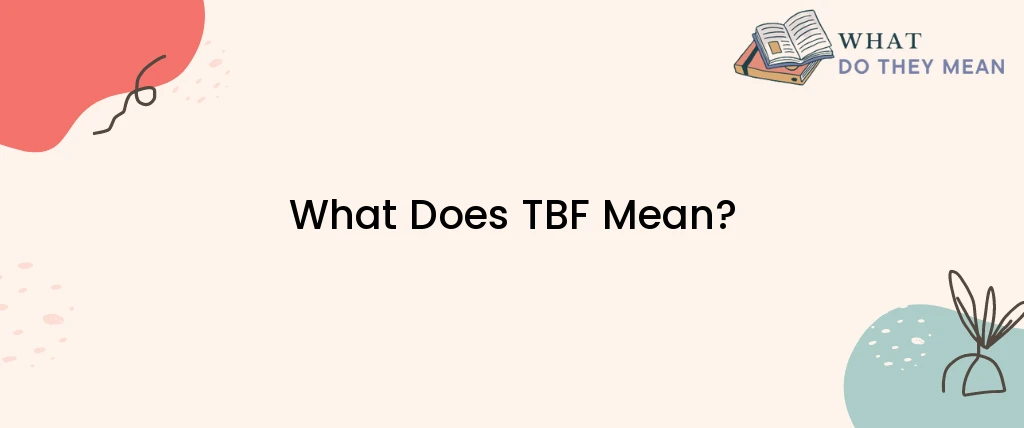In the world of texting and social media, acronyms have become increasingly popular. TBF is an acronym that stands for “To Be Fair.” It is often used to introduce a statement that acknowledges a counterpoint or alternative perspective or to provide a more nuanced view of a situation. Let’s take a closer look at what TBF means, how it is used, and why it is important.
Definition and Origin of TBF
TBF stands for “To Be Fair,” which is a phrase that is used to acknowledge a different perspective or viewpoint. It is often used to provide balance or context to a statement, especially when discussing a controversial topic or situation. The acronym TBF has its roots in internet culture and social media, where brevity and speed are key. By using acronyms like TBF, people can quickly and efficiently communicate their thoughts and ideas.
Examples of TBF in Use
TBF is a versatile acronym that can be used in a variety of contexts. Here are some examples:
- “TBF, I can see why you would think that, but I still disagree.”
- “TBF, I don’t think it’s fair to blame everything on one person.”
- “TBF, we should consider all sides of the argument before making a decision.”
In each of these examples, TBF is used to acknowledge a different perspective or viewpoint. By doing so, the speaker is able to provide a more nuanced view of the situation.
Why TBF is Important
In today’s world, it can be easy to get caught up in our own opinions and perspectives. We may be quick to dismiss others who hold different views, or we may fail to consider the broader context of a situation. TBF can help to counteract this tendency by encouraging us to acknowledge and consider alternative viewpoints.
When we use TBF, we signal to others that we are open to hearing different perspectives and that we value balance and context. This can lead to more productive conversations and a deeper understanding of complex issues. In addition, using TBF can help to build trust and credibility with others. When people see that we are willing to consider alternative viewpoints, they are more likely to view us as fair and reasonable.
Similar Acronyms to TBF
There are many other acronyms that are similar to TBF and are used to convey a similar sentiment. Some examples include:
- TBH (To Be Honest)
- IMHO (In My Honest Opinion)
- FWIW (For What It’s Worth)
- AFAIK (As Far As I Know)
Like TBF, these acronyms are often used to provide context and nuance to a statement. They can help to convey a sense of openness and honesty, which can be valuable in many different contexts.
Tips for Using TBF Effectively
If you want to use TBF effectively, there are a few tips to keep in mind:
- Be genuine: When you use TBF, make sure that you are genuinely acknowledging a different perspective. Don’t use it as a way to appear fair or balanced if you don’t actually believe it.
- Use it sparingly: TBF can be a powerful tool for acknowledging different perspectives, but it can lose its impact if you overuse it. Use it only when it is relevant and adds value to the conversation.
- Don’t use it as a crutch: TBF should not be a substitute for providing evidence or reasoning to support your argument. It should be used in conjunction with other persuasive techniques.
- Be aware of tone: TBF can be a useful way to soften the tone of a statement, but it can also come across as insincere or condescending if not used carefully. Pay attention to your tone when using TBF, and make sure that it is appropriate for the situation.
- Consider the audience: TBF may not be understood by everyone, especially those who are not familiar with internet culture or social media. Make sure that your audience understands what TBF means before using it.
By following these tips, you can use TBF effectively to acknowledge different perspectives and provide balance and context to your statements.
Conclusion
TBF is an acronym that stands for “To Be Fair.” It is often used to introduce a statement that acknowledges a counterpoint or alternative perspective or to provide a more nuanced view of a situation. By using TBF, we signal to others that we are open to hearing different perspectives and that we value balance and context. This can lead to more productive conversations and a deeper understanding of complex issues. To use TBF effectively, be genuine, use it sparingly, don’t use it as a crutch, be aware of tone, and consider the audience.

As a researcher, I am curious and driven by the pursuit of knowledge. I approach my work with a critical eye, carefully evaluating sources and methods to ensure that my findings are accurate and reliable. Whether delving into scientific studies, historical records, or cutting-edge technologies, I am always seeking to expand my understanding and make new discoveries. I am dedicated to uncovering new insights and finding solutions to complex problems, and am driven by a passion for uncovering the truth.



